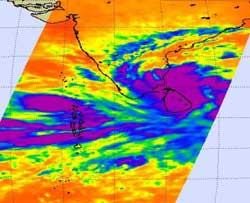ASA infrared eye sees tropical cyclone Nilam soak Sri Lanka

The AIRS instrument aboard NASA's Aqua satellite captured this image of Tropical Cyclone Nilam on Oct. 29 at 2029 4:29 p.m. EDT. The strongest storms with coldest cloud top temperatures appear in purple and were covering Sri Lanka. The purple indicates temperatures as cold as -63F (-52C).<br><br>Credit: Credit: NASA JPL, Ed Olsen<br>
The Atmospheric Infrared Sounder (AIRS) instrument aboard NASA's Aqua satellite captured an infrared image of Tropical Cyclone Nilam on Oct. 29 at 2029 4:29 p.m. EDT.
At the time of the AIRS image, the strongest storms with coldest cloud top temperatures were covering Sri Lanka and stretched into the open waters of the Northern Indian Ocean. Cloud top temperatures in those areas were as cold as -63F (-52C) and are indicative of heavy rainfall.
On Oct. 30 at 1200 UTC (8 a.m. EDT) Tropical Storm Nilam had maximum sustained winds near 45 knots (51.7 mph/83.3 kph). It was located about 265 nautical miles (305 miles/491 km) southeast of Chennai, India, near 9.4 North latitude and 82.9 East longitude and moving northwest at 6 knots (7 mph/11.1 kph).
Nilam's center was forecast to move over northern Sri Lanka and make landfall on Oct. 30 in Tamil Nadu, located in southern India. Tamil Nadu is located between Pondicherry to the north and Trivandrum to the south.
Media Contact
More Information:
http://www.nasa.govAll latest news from the category: Earth Sciences
Earth Sciences (also referred to as Geosciences), which deals with basic issues surrounding our planet, plays a vital role in the area of energy and raw materials supply.
Earth Sciences comprises subjects such as geology, geography, geological informatics, paleontology, mineralogy, petrography, crystallography, geophysics, geodesy, glaciology, cartography, photogrammetry, meteorology and seismology, early-warning systems, earthquake research and polar research.
Newest articles

Webb captures top of iconic horsehead nebula in unprecedented detail
NASA’s James Webb Space Telescope has captured the sharpest infrared images to date of a zoomed-in portion of one of the most distinctive objects in our skies, the Horsehead Nebula….

Cost-effective, high-capacity, and cyclable lithium-ion battery cathodes
Charge-recharge cycling of lithium-superrich iron oxide, a cost-effective and high-capacity cathode for new-generation lithium-ion batteries, can be greatly improved by doping with readily available mineral elements. The energy capacity and…

Novel genetic plant regeneration approach
…without the application of phytohormones. Researchers develop a novel plant regeneration approach by modulating the expression of genes that control plant cell differentiation. For ages now, plants have been the…





















